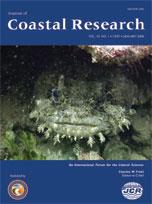Six Mile Reef, a sandy, 22-m-high shoal trending east–west and located about 7.8 km off the Connecticut coast, has a core of postglacial marine deltaic deposits mantled by tidally reworked modern sediments. Sedimentary environments off the eastern end of the shoal are characterized by processes associated with long-term erosion or nondeposition, a mobile-sediment-limited seafloor armored by gravelly sand, and scattered elongate fields of barchanoid sand waves. The barchanoid waves reach amplitudes of 20 m, are concave westward, and occur in individual and coalesced forms that become progressively more complex westward. The seafloor on and adjacent to the shoal is characterized by processes associated with coarse bedload transport and covered primarily with asymmetrical transverse sand waves. The transverse waves exceed 8 m in amplitude, have slip faces predominantly oriented to the west and southwest, and have straight, slightly sinuous, and curved crests. Megaripples, which mimic the asymmetry of the sand waves, are commonly present on stoss slopes and in troughs; current ripples are ubiquitous. The amplitude and abundance of large bedforms decrease markedly westward of Six Mile Reef. The seabed there is covered with small, degraded ripples, reflecting lower-energy environments and processes associated with sorting and reworking of sea-floor sediments.
Megaripples and current ripples on the sand waves suggest that transport is active and that the bedforms are propagating under the present hydraulic regime. Net bedload sediment transport is primarily to the west, as evidenced by textural trends of surficial sediments, orientation of the barchanoid waves, and asymmetry of the transverse waves and of the scour marks around bedrock outcrops, boulders, and shipwrecks. One exception occurs at the western tip of the shoal, where sand-wave morphology indicates long-term eastward transport, suggesting that countercurrents in this area shape the shoal and are important to its maintenance.





